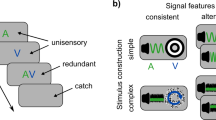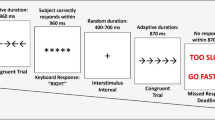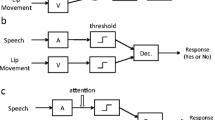Abstract
In research investigating Stroop or Simon effects, data are typically analyzed at the level of mean response time (RT), with results showing faster responses for compatible than for incompatible trials. However, this analysis provides only limited information as it glosses over the shape of the RT distributions and how they may differ across tasks and experimental conditions. These limitations have encouraged the analysis of RT distributions using delta plots. In the present review, we aim to bring together research on distributional properties of auditory and visual interference effects. Extending previous reviews on distributional properties of the Simon effect, we additionally review studies reporting distributional analyses of Stroop effects. We show that distributional analyses of sequential effects (i.e., taking into account congruency of the previous trial) capture important similarities and differences of interference effects across tasks (Simon, Stroop) as well as across sensory modalities, despite some challenges associated to this approach.


Similar content being viewed by others
Notes
In the original task, the words “man” and “girl” were used. Here, we used the monosyllabic word “Frau” (woman) instead of “Mädchen” (girl) to maximize comparability with the word “Mann” (man). Participants first practiced the respective task with which they started during a block consisting of 40 trials. Subsequently, participants performed three experimental blocks of this task with 40 trials each. After completion of the first task, participants practiced the second task during one block of 40 trials and then performed three experimental blocks of the second task with 40 trials each. Twenty-four University of Freiburg students (13 women) participated for course credit or as paid volunteers; mean age was 26 years, ranging from 18 to 46 years.
The RT distribution was divided into nine bins; slopes of the individual delta plots were estimated via ordinary least-squares regression (see also Pratte et al., 2010).
We thank Mike Pratte for pointing out this interrelation.
Key mapping was counterbalanced across participants. Participants practiced the task in a block consisting of 24 trials. Subsequently, they performed two experimental blocks of 96 trials each. Twenty-four students from University of Freiburg (17 women) participated for course credit or as paid volunteers; mean age was 22 years, ranging from 19 to 34 years.
Note that a subtle modification such as using letters (A and B) as target stimuli in the visual Simon task might in fact represent a fundamental change to the nature of the task: One may ask whether the visual Simon task used by Wascher et al. (2001) in fact reflected a spatial Stroop task, because the letters A and B might be associated with left and right responses, respectively.
References
Ashby, F. G., & Townsend, J. T. (1980). Decomposing the reaction time distribution: pure insertion and selective influence revisited. Journal of Mathematical Psychology, 21, 93–123.
Botvinick, M. M., Braver, T. S., Barch, D. M., Carter, C. S., & Cohen, J. D. (2001). Conflict monitoring and cognitive control. Psychological Review, 108, 624–652. doi:10.1037//0033-295X.108.3.624.
Burle, B., Possamaï, C.-A., Vidal, F., Bonnet, M., & Hasbroucq, T. (2002). Executive control in the Simon effect: an electromyographic and distributional analysis. Psychological Research, 66, 324–336. doi:10.1007/s00426-002-0105-6.
Burle, B., Spieser, L., Servant, M., & Hasbroucq, T. (2013). Distributional reaction time properties in the Eriksen task: Marked differences or hidden similarities with the Simon task?. Psychonomic Bulletin and Review. doi:10.3758/s13423-013-0561-6.
Burle, B., van den Wildenberg, W. P. M., & Ridderinkhof, K. R. (2005). Dynamics of facilitation and interference in cue-priming and Simon tasks. European Journal of Cognitive Psychology, 17, 619–641. doi:10.1080/09541440540000121.
Chen, Z. (2003). Attentional focus, processing load, and Stroop interference. Perception and Psychophysics, 65, 888–900. doi:10.3758/BF03194822.
Cohen, G., & Martin, M. (1975). Hemisphere differences in an auditory Stroop test. Perception and Psychophysics, 17, 79–83. doi:10.3758/BF03204002.
Davranche, K., Hall, B., & McMorris, T. (2009). Effect of acute exercise on cognitive control required during an Eriksen flanker task. Journal of Sport and Exercise Psychology, 31, 628–639.
De Fockert, J. W., Rees, G., Frith, C. D., & Lavie, N. (2001). The role of working memory in visual selective attention. Science, 291, 1803–1806. doi:10.1126/science.1056496.
De Jong, R., Liang, C–. C., & Lauber, E. (1994). Conditional and unconditional automaticity: a dual-process model of effects of spatial stimulus–response correspondence. Journal of Experimental Psychology: Human Perception and Performance, 20, 731–750. doi:10.1037/0096-1523.20.4.731.
Dittrich, K., Rothe, A., & Klauer, K. C. (2012). Increased spatial salience in the social Simon task: a response-coding account of spatial compatibility effects. Attention, Perception, and Psychophysics, 74, 911–929. doi:10.3758/s13414-012-0304-1.
Dittrich, K., & Stahl, C. (2011). Nonconcurrently presented auditory tones reduce distraction. Attention, Perception, and Psychophysics, 73, 714–719. doi:10.3758/s13414-010-0064-8.
Dittrich, K., & Stahl, C. (2012). Selective impairment of auditory selective attention under concurrent cognitive load. Journal of Experimental Psychology: Human Perception and Performance, 38, 618–627. doi:10.1037/a0024978.
Dolk, T., Hommel, B., Prinz, W., & Liepelt, R. (2013). The (not so) social Simon effect: a referential coding account. Journal of Experimental Psychology: Human Perception and Performance, 39, 1248–1260. doi:10.1037/a0031031.
Egner, T. (2007). Congruency sequence effects and cognitive control. Cognitive, Affective, and Behavioral Neuroscience, 7, 380–390. doi:10.3758/CABN.7.4.380.
Elliott, E. M., Morey, C. C., Morey, R. D., Eaves, S. D., Shelton, J. T., & Lutfi-Proctor, D. A. (2014). The role of modality: auditory and visual distractors in Stroop interference. Journal of Cognitive Psychology, 26, 15–26. doi:10.1080/20445911.2013.859133.
Forstmann, B. U., van den Wildenberg, W. P. M., & Ridderinkhof, K. R. (2008). Neural mechanisms, temporal dynamics, and individual differences in interference control. Journal of Cognitive Neuroscience, 20, 1854–1865. doi:10.1162/jocn.2008.20122.
Friedman, N. P., & Miyake, A. (2004). The relations among inhibition and interference control functions: a latent-variable analysis. Journal of Experimental Psychology: General, 133, 101–135. doi:10.1037/0096-3445.133.1.101.
Gratton, G., Coles, M. G. H., & Donchin, E. (1992). Optimizing the use of information: strategic control of activation of responses. Journal of Experimental Psychology: General, 121, 480–506. doi:10.1037//0096-3445.121.4.480.
Green, E. J., & Barber, P. J. (1981). An auditory Stroop effect with judgments of speaker gender. Perception and Psychophysics, 30, 459–466. doi:10.3758/BF03204842.
Guagnano, D., Rusconi, E., & Umiltà, C. A. (2010). Sharing a task or sharing space? On the effect of the confederate in action coding in a detection task. Cognition, 114, 348–355. doi:10.1016/j.cognition.2009.10.008.
Hamers, J. F., & Lambert, W. E. (1972). Bilingual interdependencies in auditory perception. Journal of Verbal Learning and Verbal Behavior, 11, 303–310. doi:10.1016/S0022-5371(72)80091-4.
Hasbroucq, T., & Guiard, Y. (1992). The effects of intensity and irrelevant location of a tactile stimulation in a choice reaction time task. Neuropsychologia, 30, 91–94. doi:10.1016/0028-3932(92)90017-G.
Hazeltine, E., Akçay, C., & Mordkoff, J. T. (2011). Keeping Simon simple: examining the relationship between sequential modulations and feature repetitions with two stimuli, two locations and two responses. Acta Psychologica, 136, 245–252. doi:10.1016/j.actpsy.2010.07.011.
Hommel, B. (1994). Spontaneous decay of response-code activation. Psychological Research, 56, 261–268. doi:10.1007/BF00419656.
Hommel, B. (1998). Event files: evidence for automatic integration of stimulus–response episodes. Visual Cognition, 5, 183–216. doi:10.1080/713756773.
Hommel, B. (2011). The Simon effect as tool and heuristic. Acta Psychologica, 136, 189–202. doi:10.1016/j.actpsy.2010.04.011.
Hommel, B., Proctor, R. W., & Vu, K.-P. L. (2004). A feature-integration account of sequential effects in the Simon task. Psychological Research, 68, 1–17. doi:10.1007/s00426-003-0132-y.
Jiménez, L., & Méndez, A. (2013). It is not what you expect: dissociating conflict adaptation from expectancies in a Stroop task. Journal of Experimental Psychology: Human Perception and Performance, 39, 271–284. doi:10.1037/a0027734.
Kahneman, D., & Chajczyk, D. (1983). Tests of the automaticity of reading: dilution of Stroop effects by color-irrelevant stimuli. Journal of Experimental Psychology: Human Perception and Performance, 9, 497–509. doi:10.1037//0096-1523.9.4.497.
Kanske, P., & Kotz, S. A. (2012). Effortful control, depression, and anxiety correlate with the influence of emotion on executive attentional control. Biological Psychology, 91, 88–95. doi:10.1016/j.biopsycho.2013.02.003.
Kerns, J. G., Cohen, J. D., MacDonald, A. W., Cho, R. Y., Stenger, V. A., & Carter, C. S. (2004). Anterior cingulate conflict monitoring and adjustments in control. Science, 303, 1023–1026. doi:10.1126/science.1089910.
Kim, S.-Y., Kim, M.-S., & Chun, M. M. (2005). Concurrent working memory load can reduce distraction. Proceedings of the National Academy of Sciences, 102, 16524–16529. doi:10.1073/pnas.0505454102.
Leboe, L. C., & Mondor, T. A. (2007). Item-specific congruency effects in nonverbal auditory Stroop. Psychological Research, 71, 568–575. doi:10.1007/s00426-006-0049-3.
Liepelt, R., Wenke, D., Fischer, R., & Prinz, W. (2011). Trial-to-trial sequential dependencies in a social and non-social Simon task. Psychological Research, 75, 366–375. doi:10.1007/s00426-010-0314-3.
Lu, C.-H., & Proctor, R. W. (1995). The influence of irrelevant location information on performance: a review of the Simon and spatial Stroop effects. Psychonomic Bulletin and Review, 2, 174–207. doi:10.3758/BF03210959.
MacLeod, C. M. (1991). Half a century of research on the Stroop effect: an integrative review. Psychological Bulletin, 109, 163–203. doi:10.1037//0033-2909.109.2.163.
Matzke, D., Dolan, C. V., Logan, G. D., Brown, S. D., & Wagenmakers, E.-J. (2013). Bayesian parametric estimation of stop-signal reaction time distributions. Journal of Experimental Psychology: General, 142, 1047–1073. doi:10.1037/a0030543.
Matzke, D., & Wagenmakers, E.-J. (2009). Psychological interpretation of the ex–Gaussian and shifted Wald parameters: a diffusion model analysis. Psychonomic Bulletin and Review, 16, 798–817. doi:10.3758/PBR.16.5.798.
Mayr, U., Awh, E., & Laurey, P. (2003). Conflict adaptation effects in the absence of executive control. Nature Neuroscience, 6, 450–452. doi:10.1038/nn1051.
Morgan, A. L. R., & Brandt, J. F. (1989). An auditory Stroop effect for pitch, loudness, and time. Brain and Language, 36, 592–603. doi:10.1016/0093-934X(89)90088-6.
Neumann, O., van der Heijden, A. H. C., & Allport, D. A. (1986). Visual selective attention: introductory remarks. Psychological Research, 48, 185–188. doi:10.1007/BF00309082.
Notebaert, W., Gevers, W., Verbruggen, F., & Liefooghe, B. (2006). Top-down and bottom-up sequential modulations of congruency effects. Psychonomic Bulletin and Review, 13, 112–117. doi:10.3758/BF03193821.
O’Brien, J. C., Williams, H. G., Bundy, A., Lyons, J., & Mittal, A. (2008). Mechanisms that underlie coordination in children with developmental coordination disorder. Journal of Motor Behavior, 40, 43–61. doi:10.3200/JMBR.40.1.43-61.
Pratte, M. S., Rouder, J. N., Morey, R. D., & Feng, C. (2010). Exploring the differences in distributional properties between Stroop and Simon effects using delta plots. Attention, Perception, and Psychophysics, 72, 2013–2025. doi:10.3758/APP.72.7.2013.
Proctor, R. W., Miles, J. D., & Baroni, G. (2011). Reaction time distribution analysis of spatial correspondence effects. Psychonomic Bulletin and Review, 18, 242–266. doi:10.3758/s13423-011-0053-5.
Proctor, R. W., & Shao, C. (2010). Does the contribution of stimulus-hand correspondence to the auditory Simon effect increase with practice? Experimental Brain Research, 204, 131–137. doi:10.1007/s00221-010-2284-5.
Proctor, R. W., Vu, K.-P. L., & Nicoletti, R. (2003). Does right-left prevalence occur for the Simon effect? Perception and Psychophysics, 65, 1318–1329. doi:10.3758/BF03194855.
Ratcliff, R. (1978). A theory of memory retrieval. Psychological Review, 85, 59–108. doi:10.1037/0033-295X.85.2.59.
Ridderinkhof, K. R. (2002a). Activation and suppression in conflict tasks: Empirical clarification through distributional analyses. In W. Prinz & B. Hommel (Eds.), Common mechanisms in perception and action: attention and performance, XIX (pp. 494–519). Oxford: Oxford University Press.
Ridderinkhof, K. R. (2002b). Micro- and macro-adjustments of task set: activation and suppression in conflict tasks. Psychological Research, 66, 312–323. doi:10.1007/s00426-002-0104-7.
Ridderinkhof, K. R., Scheres, A., Oosterlaan, J., & Sergeant, J. A. (2005). Delta plots in the study of individual differences: new tools reveal response inhibition deficits in AD/HD that are eliminated by methylphenidate treatment. Journal of Abnormal Psychology, 114, 197–215. doi:10.1037/0021-843X.114.2.197.
Roberts, K. L., & Hall, D. A. (2008). Examining a supramodal network for conflict processing: a systematic review and novel functional magnetic resonance imaging data for related visual and auditory Stroop tasks. Journal of Cognitive Neuroscience, 20, 1063–1078. doi:10.1162/jocn.2008.20074.
Salzer, Y., Aisenberg, D., Oron-Gilad, T., & Henik, A. (2013). In touch with the Simon effect. Experimental Psychology. doi:10.1027/1618-3169/a000236.
Schumacher, E. H., Schwarb, H., Lightman, E., & Hazeltine, E. (2011). Investigating the modality specificity of response selection using a temporal flanker task. Psychological Research, 75, 499–512. doi:10.1007/s00426-011-0369-9.
Schwarz, W., & Miller, J. (2012). Response time models of delta plots with negative-going slopes. Psychonomic Bulletin and Review, 19, 555–574. doi:10.3758/s13423-012-0254-6.
Sebanz, N., Knoblich, G., & Prinz, W. (2003). Representing others’ actions: just like one’s own? Cognition, 88, B11–B21. doi:10.1016/S0010-0277(03)00043-X.
Sebastian, A., Pohl, M. F., Klöppel, S., Feige, B., Lange, T., Stahl, C., et al. (2013). Disentangling common and specific neural subprocesses of response inhibition. NeuroImage, 64, 601–615. doi:10.1016/j.neuroimage.2012.09.020.
Sharma, D., Booth, R., Brown, R., & Huguet, P. (2010). Exploring the temporal dynamics of social facilitation in the Stroop task. Psychonomic Bulletin amd Review, 17, 52–58. doi:10.3758/PBR.17.1.52.
Shiu, L.-P., & Kornblum, S. (1999). Stimulus–response compatibility effects in go-no-go tasks: a dimensional overlap account. Perception and Psychophysics, 61, 1613–1623. doi:10.3758/BF03213122.
Shor, R. E. (1975). An auditory analog of Stroop test. Journal of General Psychology, 93, 281–288.
Simon, J. R. (1990). The effects of an irrelevant directional cue on human information processing. In R. W. Proctor & T. G. Reeve (Eds.), Stimulus–response compatibility: An integrated perspective (pp. 31–86). Amsterdam: North-Holland.
Simon, J. R., & Small, A. M. (1969). Processing auditory information: interference from an irrelevant cue. Journal of Applied Psychology, 53, 433–435. doi:10.1037/h0028034.
Soutschek, A., Schwarzkopf, W., Finke, K., Hennig-Fast, K., Müller, H. J., Riedel, M., et al. (2013). Interference control in adult ADHD: no evidence for interference control deficits if response speed is controlled by delta plots. Acta Psychologica, 143, 71–78. doi:10.1016/j.actpsy.2013.02.013.
Spapé, M. M., & Hommel, B. (2008). He said, she said: episodic retrieval induces conflict adaptation in an auditory Stroop task. Psychonomic Bulletin and Review, 15, 1117–1121. doi:10.3758/PBR.15.6.1117.
Speckman, P. L., Rouder, J. N., Morey, R. D., & Pratte, M. S. (2008). Delta plots and coherent distribution ordering. The American Statistician, 62, 262–266. doi:10.1198/000313008X333493.
Stahl, C., Voss, A., Schmitz, F., Nuszbaum, M., Tüscher, O., Lieb, K., et al. (2013). Behavioral components of impulsivity. Journal of Experimental Psychology: General. doi:10.1037/a0033981.
Stroop, J. R. (1935). Studies of interference in serial verbal reactions. Journal of Experimental Psychology, 18, 643–662.
Stürmer, B., Leuthold, H., Soetens, E., Schröter, H., & Sommer, W. (2002). Control over location-based response activation in the Simon task: behavioral and electrophysiological evidence. Journal of Experimental Psychology: Human Perception and Performance, 28, 1345–1363. doi:10.1037//0096-1523.28.6.1345.
Valle-Inclán, F., & Redondo, M. (1998). On the automaticity of ipsilateral response activation in the Simon effect. Psychophysiology, 35, 366–371. doi:10.1017/S0048577298960917.
van den Wildenberg, W. P. M., Wylie, S. A., Forstmann, B. U., Burle, B., Hasbroucq, T., & Ridderinkhof, K. R. (2010). To head or to heed? Beyond the surface of selective action inhibition: a review. Frontiers in Human Neuroscience, 4, 1–13. doi:10.3389/fnhum.2010.00222.
Voss, A., Nagler, M., & Lerche, V. (2013a). Diffusion models in experimental psychology: a practical introduction. Experimental Psychology, 60, 385–402. doi:10.1027/1618-3169/a000218.
Voss, A., Rothermund, K., Gast, A., & Wentura, D. (2013b). Cognitive processes in associative and categorical priming: a diffusion model analysis. Journal of Experimental Psychology: General, 142, 536–559. doi:10.1037/a0029459.
Wagenmakers, E.-J., & Brown, S. (2007). On the linear relation between the mean and the standard deviation of a response time distribution. Psychological Review, 114, 830–841. doi:10.1037/0033-295X.114.3.830.
Wascher, E., Schatz, U., Kuder, T., & Verleger, R. (2001). Validity and boundary conditions of automatic response activation in the Simon task. Journal of Experimental Psychology: Human Perception and Performance, 27, 731–751. doi:10.1037//0096-1523.27.3.731.
Wiegand, K., & Wascher, E. (2005). Dynamic aspects of stimulus–response correspondence: evidence for two mechanisms involved in the Simon effect. Journal of Experimental Psychology: Human Perception and Performance, 31, 453–464. doi:10.1037/0096-1523.31.3.453.
Wiegand, K., & Wascher, E. (2007). The Simon effect for vertical S–R relations: changing the mechanism by randomly varying the S–R mapping rule? Psychological Research, 71, 219–233. doi:10.1007/s00426-005-0023-5.
Wühr, P., & Ansorge, U. (2005). Exploring trial-by-trial modulations of the Simon effect. The Quarterly Journal of Experimental Psychology: Section A, 58, 705–731. doi:10.1080/02724980443000269.
Wylie, S. A., Ridderinkhof, K. R., Bashore, T. R., & van den Wildenberg, W. P. M. (2010). The effect of Parkinson’s disease on the dynamics of on-line and proactive cognitive control during action selection. Journal of Cognitive Neuroscience, 22, 2058–2073. doi:10.1162/jocn.2009.21326.
Zhang, J., & Kornblum, S. (1997). Distributional analysis and De Jong, Liang, and Lauber’s (1994) dual-process model of the Simon effect. Journal of Experimental Psychology: Human Perception and Performance, 23, 1543–1551. doi:10.1037//0096-1523.23.5.1543.
Acknowledgments
The research reported in this paper was supported by a grant of the Landesstiftung Baden-Württemberg foundation to the third author. We are grateful to Iring Koch, Michael Pratte, Kim-Phuong L. Vu, and an anonymous reviewer for many excellent and constructive comments. We also thank Michael Pratte for providing raw data.
Author information
Authors and Affiliations
Corresponding author
Rights and permissions
About this article
Cite this article
Dittrich, K., Kellen, D. & Stahl, C. Analyzing distributional properties of interference effects across modalities: chances and challenges. Psychological Research 78, 387–399 (2014). https://doi.org/10.1007/s00426-014-0551-y
Received:
Accepted:
Published:
Issue Date:
DOI: https://doi.org/10.1007/s00426-014-0551-y




